Latomie
Parco Archeologico della Neapolis
Useful Information
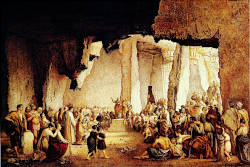

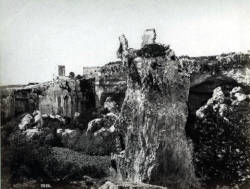
| Location: |
Parco Archeologico della Neapoli, Via del Teatro Greco, 96100 Siracusa SR.
Siracusa, towards Ortigia. Parking Neapolis, Viale Augusto, 96100 Siracusa SR. (37.075330, 15.277976) |
| Open: |
All year Mon-Sat 8:30-17:30, last entry 16, Sun, Hol 8:30-13:40, last entry 12:30. The tickets are sold by online booking, and the actual open hours are very complicated now. But above times are almost correct most of the year. [2024] |
| Fee: |
Adults EUR 16.50, Children (0-17) free, Students EUR 9.75, Disabled free. Admission is free on 1st Sunday of Month. [2024] |
| Classification: |
 Rock Mine Rock Mine
|
| Light: | n/a |
| Dimension: | |
| Guided tours: | self guided |
| Photography: | allowed |
| Accessibility: | no |
| Bibliography: | |
| Address: |
Parco Archeologico della Neapoli, Via del Teatro Greco, 96100 Siracusa SR, Tel: +39-0931-876602.
E-mail: |
| As far as we know this information was accurate when it was published (see years in brackets), but may have changed since then. Please check rates and details directly with the companies in question if you need more recent info. |
|
History
| 17th century | Grotta dei Cordari used by rope makers. |
| 1608 | Michelangelo di Caravaggio visited Siracusa and also this place. |
| 1952-1955 | Parco archeologico della Neapolis created. |
| 1983 | Grotta dei Cordari closed for renovation after the last cordari left the place. |
| 2005 | inscribed on the UNESCO World Heritage List. |
| 2021 | Grotta dei Cordari reopened to the public. |
Description
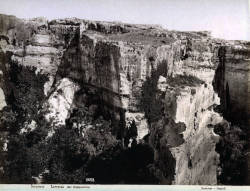
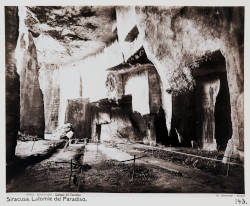

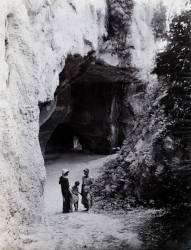

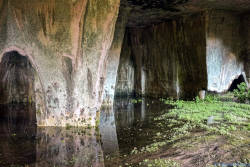
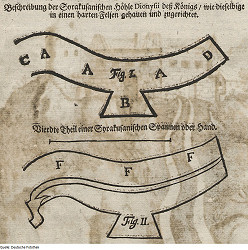
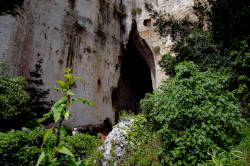
Latomie (litos=stone, temnos=cut) is a strange place, near Siracusa, which is a series of historic quarries for the city of Syracuse. It was opened by the Greek settlers to get material for their temples, roads and fortifications. At this time 4.7 Mio. m³ of rock were removed. There are twelve quarries arranged in a 1.5 km long bow following the edge of a limestone terrace towards Ortigia. Latomia is a quarry, latomie is the plural and translates "the quarries", and actually the place is still known among locals by this common name. All the sites open to the tourists are today part of the Parco Archeologico della Neapolis, so that’s the official name. It has nothing to do with the city Napoli, Nea polis (new city) is the name of the quarter of Syracuse where it is located.
The blocks were cut out of the rock, as it is limestone or tufa, which is rather soft when it is wet. Later it was dried in the sun and became hard. This rock contains a lot of air bubbles, similar to modern isolating construction material. In the hot Sicilian summers, this was very useful to keep the heat outside the houses. The Latomie looks rather strange, as the workers followed the best rock qualities, and thus a strange labyrinth of quarries, shelters and caves was created. But the shape of this area also changed due to erosion and the frequent earthquakes of this volcanic island. Today the quarries are much wider than originally, and so the sun is shining into the crevice allowing the growth of plants. The caves were built by slave workers, prisoners and captives of war. For example, the Carthagans which were captured at Gelone 480 BC. Or the 7,000 Athenians, which survived the massacre at Asinaro 413 BC. The quarries were a high security prison, with no chance for the prisoners to escape.
Today there are four quarries open to the public: Latomia Intagliatella, Latomie dei Cappuccini, Latomie del Paradiso, and Latomie di S. Venera. Two more are private and not open to the public. All other quarries are covered by the modern city and do not exist any more.
- Latomie del Paradiso: is the first quarry which was opened to the public. It is one of the biggest and the deepest of all quarries. The flat floor was used for a citrus grove for centuries. It is the location of the Orecchio di Dionigi (Ear of Dionysios), see below.
- Latomia Intagliatella: one of the smaller quarries, impressive for its high arches and pillars. Connected by a modern tunnel with Latomie del Paradiso.
- Latomie dei Cappuccini: was originally called la Perriera od la Pietraia, which was derived from the word pietra (rock). This is the place which was used as a quarry by the Greeks. The absolutely vertical caves make any try to escape futile. This place was bought in 1592 by Capuchin monks, an autonomous branch of the Franciscan order, which explains the modern name.
- Latomie di Santa Venera: this quarry was transformed into a garden in the 6th century, today it is the Botanical Garden of Siracuse. A notable highlight is the Albero secolare tree (Ficus macrophylla columnaris). Part of this place is the Necropoli Grotticelle, a Greek and Roman cemetery with many cave tombs.
The Grotta dei Cordari (Grotto of the Ropemakers) really looks and feels a bit like a natural cave, as the moisture allows the growth of typical plants. It was named after the cordari (rope makers) who used this huge chamber to make ropes since the 17th century. This place was cool and moist, which was good for the ropes. The tradition of making ropes here was abandoned only a few decades ago. The cave was closed for renovation for 38 years and was reopened to the public in 2021.
The Grotta del Ninfeo (Grotto of the Nymphaeum) is located north of the Greeek theater, on a rectangular terrace. Once there were statues dedicated to the Muses at its entrance. According to local lore, this is the ancient site of the Mouseion, the sanctuary of the Muses. As a result the actors gathered here, before descending into the theatre. Inside is a rectangular basin into which water cascades from a cavity in the bottom of the rock face. Votive shrines were cut into the wall at the entrance, which were used for the practice of hero worship.
The Orecchio di Dionigi (Ear of Dionysius) is a 65 m long tunnel which is between 5 m and 11 m wide and 23 m high. It is shaped like a gothic arch, with a pointy apex. The strange shape gives the place strange acoustics, the sound is reflected up to 16 times. Michelangelo di Caravaggio visited Siracusa in 1608. He visited this cave in the company of the Siracusan historian Vincenzo Mirabella. Caravaggio named this cave Orecchio di Dionigi because of a legend about the tyrant Dionysius the elder, who is said to have constructed this cave as a prison. The strange acoustics allowed the tyrant to spy his captives by sitting at a place high above where even the calmest whisper was amplified to be understandable. But despite this nice story, the form of the cave is just a result of the mining technique used by the quarry workers. They started at the top and removed layer after layer at the floor of the cave,slightly widening it with every layer. The acoustics is just a coincidence.
The Grotta del Salnitro is located in the same cliff face as Orecchio di Dionigi and Grotta dei Cordari, and it is quite similar in its form to latter. Again, the form is a result of the used quarrying technique.
The site is surrounded by numerous other ancient sites, for example the Tomba di Archimede, the Roman Amphitheatre, the Teatro Greco (Greek Theatre), and the Tecnoparco Museo di Archimede. Some are included in the ticket, others require an additional fee, and some are freely accessible, like the Tempio Circolare Ieroniano. The starting point is the Biglietteria del Parco Archeologico, which is located on Via Luigi Bernaò Brea, right after the turnoff from Via Ettore Romagnoli. This is definitely a place to spend a full day. Do not forget sun protection and some water.
The Neapolis Archaeological Park was created between 1952 and 1955 by the Superintendency of Eastern Sicily, under Superintendent Luigi Bernabò Brea. It was financed by financial funds from the Cassa per il Mezzogiorno. There were excavations by D. Lo Faso, Duke of Serradifalco, in 1840. Later the two well-known archaeologists Paolo Orsi and Luigi Bernabò Brea made excavations. The park was created with the intention of enclosing in a single protected site all the monuments that were located in that area. The main purpose was to protect historic sites from urban expansion. This was actually quite important, as the city grew from 66,000 to 117,000 inhabitants in the next three decdes. As a result, new homes were built on ancient sites like necropolises, baths, temples, or roads. But the Neapolis Park worked as intended and protected the sites inside its borders. And beneath the protection of historic monuments, the park also protects the delicate flora of the area.
- See also
 Subterranean World Heritage List
Subterranean World Heritage List Search DuckDuckGo for "Latomie"
Search DuckDuckGo for "Latomie" Google Earth Placemark
Google Earth Placemark OpenStreetMap
OpenStreetMap Parco archeologico della Neapolis
Parco archeologico della Neapolis  - Wikipedia (visited: 09-FEB-2023)
- Wikipedia (visited: 09-FEB-2023) Ear of Dionysius - Wikipedia
Ear of Dionysius - Wikipedia Archaeological and Landscape Park of Syracuse, Eloro, Villa del Tellaro and Akrai, official website (visited: 09-FEB-2023)
Archaeological and Landscape Park of Syracuse, Eloro, Villa del Tellaro and Akrai, official website (visited: 09-FEB-2023) Parco Archeologico Della Neapolis (visited: 26-JUN-2024)
Parco Archeologico Della Neapolis (visited: 26-JUN-2024) Syracuse and the Rocky Necropolis of Pantalica - UNESCO World Heritage List (visited: 25-JUNI-2024)
Syracuse and the Rocky Necropolis of Pantalica - UNESCO World Heritage List (visited: 25-JUNI-2024)
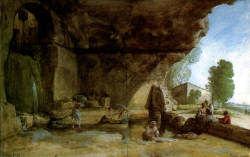
 Index
Index Topics
Topics Hierarchical
Hierarchical Countries
Countries Maps
Maps